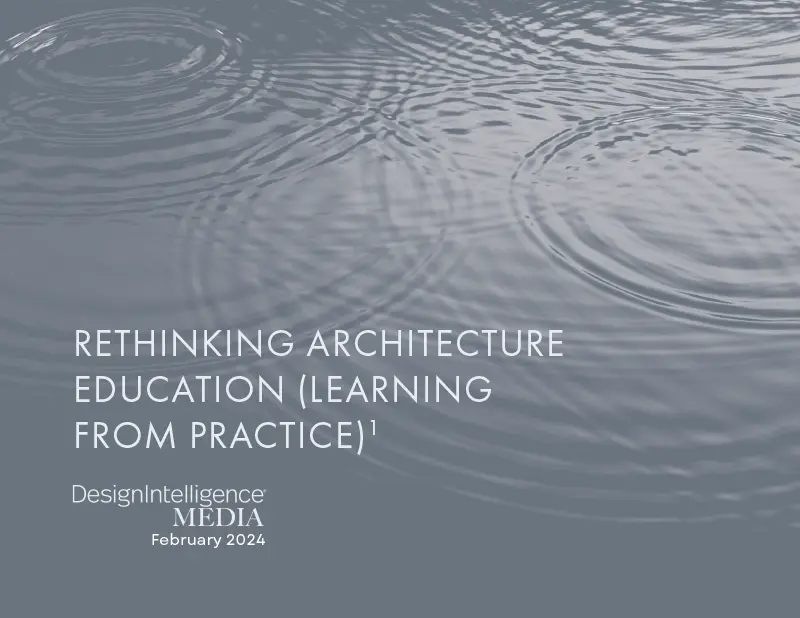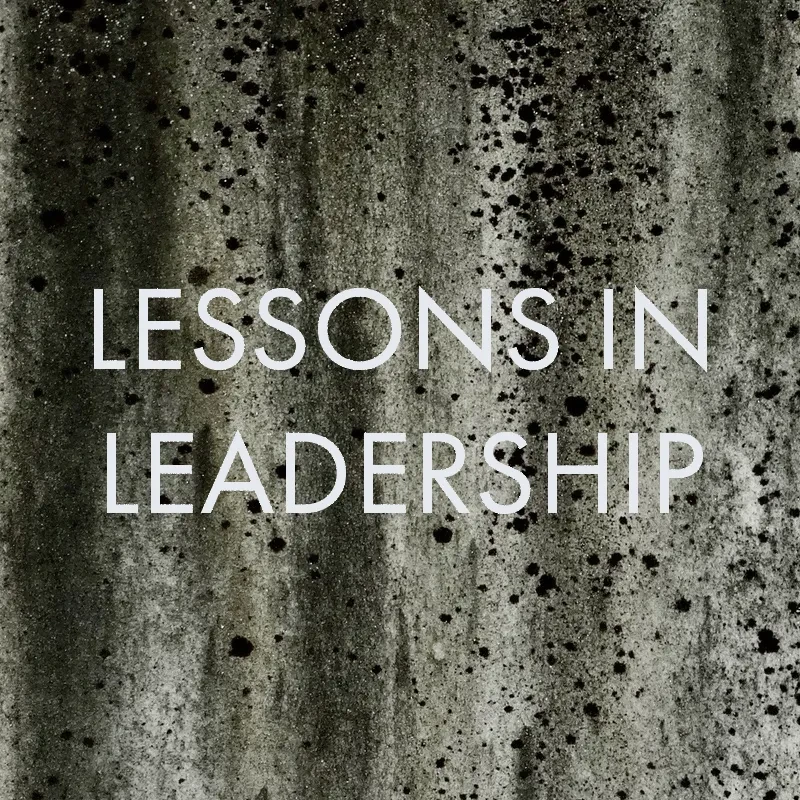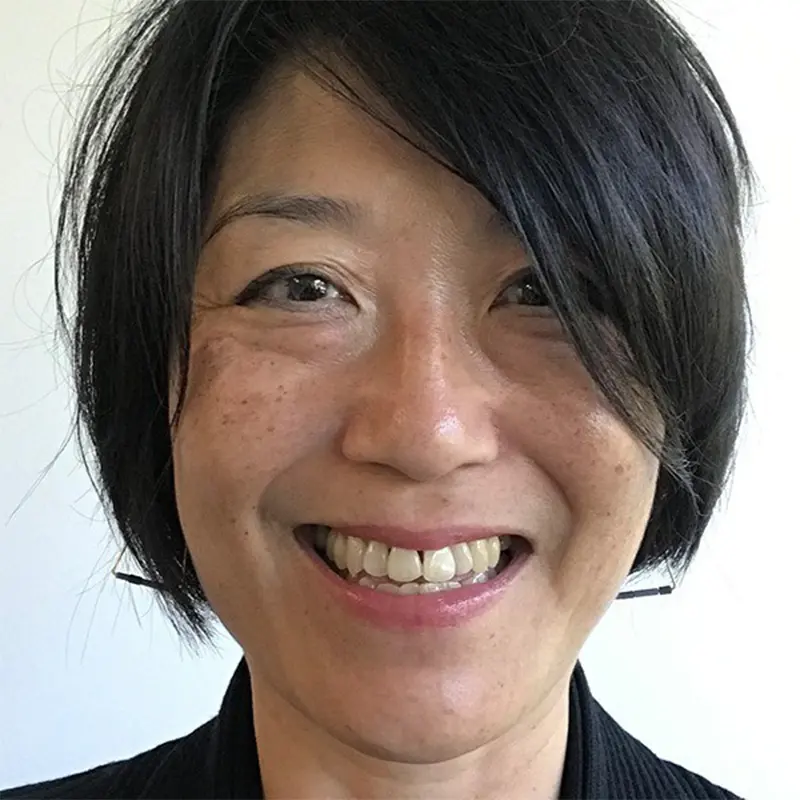
Rethinking Architecture Education (Learning from Practice)1
Julie Ju-Youn Kim, RA, AIA, NCARB
William H. Harrison Professor & Chair, School of Architecture, College of Design, Georgia Institute of Technology
February 28, 2024
Abstract
By interrogating the nature of architectural education, we can investigate opportunities for the discipline of architecture to engage culture and society in more significant ways beyond skills preparation. Connecting ideas of design as a creative pursuit with integrated knowledge from various disciplines, the academic design studio carries tremendous potential in preparing students to address increasingly multifaceted and complex problems, expanding the role of architects as facilitators, choreographers, strategists, directors and leaders. While design studios and interdisciplinarity are well-represented in scholarship, the relationship between practice and education set within the interdisciplinary framework is nascent territory. Opportunities exist to exploit the overlaps where practice may enter the discussion about interdisciplinarity in relationship to education. Sharing her assumptions, Julie Kim wonders if by remaining “in our lane” in discipline, we impose false limits on our capacity to radically rethink architecture education and bridge the gap the between the academy and practice.
Setting the Stage for Interdisciplinarity
“The strength of all things comes from the in-between.” — Sanskrit saying
In my own work as an educator and architect, I remain intent on building capacity in critical thinking and thinking across disciplines — even as I continue to refine my own clarity on what constitutes disciplinary thinking. A productive opportunity exists in education — one that offers students a platform to engage in interdisciplinary problem-solving in the pursuit of seeking one of many possible solutions. We know that in a truly interdisciplinary project each participant has a different perspective on the problem. Each contributor brings their own respective disciplinary expertise to the conversation. Although each expert may not challenge their own assumptions about their disciplines, the hope is that they each negotiate the differences to work toward a collective shared approach. In fact, established approaches in schools of architecture curricula tend to model interdisciplinary exercises in the design studio. In the interdisciplinary design studio, we bring together students from different schools to collaborate on shared problems. We imagine optimal outcomes with the belief that exposing students to this methodology early on will pay off later as they become the leaders in practice. The premise here is that as they engage in learning by doing, they will build a fundamental understanding of the critical role the architect plays in the process of collaborating and seeking solutions.
Is This a Fiction in My Own Mind?
In the academic arena, students and faculty are traditionally defined by their disciplines. In other words, we might have a School of Architecture, a School of Mechanical Engineering, a School of Biology and so on. On the other hand, we recognize in practice that we will collaborate with a wide range of disciplinary experts. So, in the academy, we set up the aforementioned interdisciplinary studios, a fictional collaborative framework. We imagine students will bring their relevant disciplinary expertise to bear, and we imagine that one plus one will equal more than two.
The truth is we are fortunate when one plus one actually equals two.
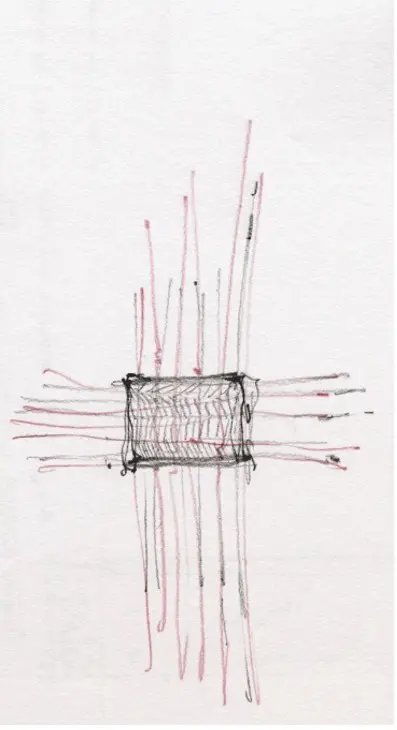
Author Sketch
The terms multidisciplinary, interdisciplinary and transdisciplinary are often used interchangeably. While each describes different engagement modalities, all are connected by the actions of producing, expanding and advancing knowledge — in our case, architectural knowledge. As architects in practice, we are familiar with modes of interdisciplinary engagement, conventionally played out in project team structures that include architects, engineers and other consultants all collaborating on a single project with a shared aim. As an architect in education, I am deeply invested in positioning platforms for students, helping them see acts of design as creative pursuits that require integrated knowledge from various disciplines organized by structured collaborative teamwork. I see students collaborating in the design studio as a platform for our future leaders in practice to build critical lifelong skills. I imagine, then, that our students are prepared to address increasingly multifaceted and complex problems, expanding the role of architects — as facilitators, choreographers, strategists, directors, leaders. I, however, recognize that I, myself, have not truly questioned the role architects play or the disciplinary expertise they offer. I find myself wondering ... by remaining “in our lane” or discipline, do we impose false limits on our capacity for radical thinking?
In the academy, we can agree on shared aims to build students’ capacities in critical thinking and to encourage strategic and smart thinking across disciplines. Clear design thinking through structured methodologies grounds such collaborative engagement. Faculty and related stakeholder partners offer the exploratory questions within a structured pedagogical framework to prepare our students to critically confront relevant contemporary challenges. In response to an initial set of defined provocations, faculty carry an embedded expectation for the students to take initiative to search available literature, evidence and relevant precedents so they may develop their own lenses to understand the problems. As schools continue to redefine and redescribe the nature of architectural education, we must also ask other questions about the possibility for the discipline of architecture itself to engage culture and society in more significant ways, beyond skills preparation. And, for architecture to maintain its relevance, we must establish its placement more broadly between the arts, sciences and humanities — engaging in discourse beyond itself. In my own experiences at Georgia Tech, as program director of the Bachelor of Science in Architecture from 2015-2022, I was explicitly interested in testing ideas of interdisciplinarity and collaboration across the curriculum. In 2016, I introduced a new curricular model for interdisciplinary design studios in the undergraduate program in the School of Architecture at Georgia Tech. Establishing annual engagement with the Capstone Design Expo — a hallmark at Georgia Tech with a long tradition in engineering — I expanded and nurtured cross-campus relationships to include interdisciplinary architecture teams in this culminating experience, opening the conversation across disciplines to extend the social structures of collaboration between divergent voices.2
Across and Through the Space Between the Academy and Practice
In his “Manifesto for Transdisciplinarity” (2002), Basarab Nicolescu asserts, “Today, even two specialists in the same discipline must make a serious effort to understand their respective results.” He continues with this assertion:
“Even a group comprised of the best specialists from all the various disciplines would only be able to develop a generalized incompetence, for the simple reason that the sum of total competencies is not competence: on a technical level, the intersection between different domains of knowledge is an empty ensemble.”
This sounds dire: “Intersections between different domains of knowledge are an empty ensemble.” But we also know that the intersections between different domains of knowledge can be pregnant with potential. We know diverse sets of voices and perspectives can impact the outcome of a project. We also recognize, even within our own discipline, there may be misalignments in approach, methodology and general competence. This is all true; however, I see this as a call to action. Learning to effectively collaborate with people who hold expertise in one’s own discipline as well as other specialties — including engineering, construction, real estate development, building technology and other allied disciplines — is essential to the success of the next generation of architects. As important, the architect’s ability to accommodate the external pressures of clients’ desires and stated aims will also require them to understand, interpret and synthesize inputs from multiple perspectives and disciplines. We — the architects — hold the potential to operate through, between and across disciplines. Preparing our students to be leaders in this regard is one of the core visions of interdisciplinary approaches to architectural design and inquiry in schools of architecture.
While the pressures of such integrated discussions are more prevalent in advanced graduate studies, I believe we must start earlier, offering such opportunities to students at the beginning of their careers. By establishing an interdisciplinary curriculum in undergraduate degree programs, we offer opportunities for architecture students to deliberately build and foster partnerships with others outside their own conceptual space. By doing so, we extend creative and intellectual capacity for students. Moreover, we offer the scaffold for building leadership skills, supporting students to strengthen their abilities to communicate and collaborate effectively. We help sharpen their agility as design thinkers. We emphasize design as a creative pursuit that requires integrated knowledge from various disciplines, with a common shared focus toward the resolution of a design project.
I have been asked why include undergraduates at all? Undergraduate students are arguably only just beginning to shape their leadership skills. Is an inexperienced, beginning student ready to engage in interdisciplinary exercises when they are only just learning their own discipline? Perhaps not. But these students are also ready to challenge boundaries and constraints. For undergraduate students especially, we can entertain broad definitions of design inquiry and experiences precisely because we are not constrained nor limited by accreditation requirements overlaid on professional degree programs. Free of such constraints, undergraduate programs can enjoy greater flexibility in design-focused curricula to leverage the critical creative thinking of our students.
But should we not also apply the same revolutionary thinking to our professional degree programs? The aim of most, if not all, professional degree programs is to prepare students to be competitive, skilled and versed in professional practice. To be deliberately provocative here: Are professional degree programs forward-thinking, and, by extension, is professional practice likewise forward-thinking enough? Certainly, programs like the Integrated Path to Architectural Licensure (IPAL) define a strict conduit between academic and professional spaces. With specific pressures like IPAL, as well as those imposed by the normative external accreditation review, does this compel programs, in turn, to churn out students who can competently and capably navigate conventional professional practice but are not necessarily equipped to aggressively and assertively initiate or lead necessary change to address big, global challenges?
One of the core values shared by the National Architectural Accrediting Board (NAAB), the American Institute of Architects (AIA), the Association of Collegiate Schools of Architecture (ACSA) and the National Council of Architectural Registration Board (NCARB) centers on knowledge and innovation. This notion of advancing knowledge and innovation suggests a rich and generous space that allows risky experimentation. We know, however, that risk is a double-edged sword. In other words, we want to test the limits, but are equally constrained by external and internal limitations. Herein lies the tension. If we embrace and welcome this pressure, the question facing us is how we might shape our professional degree programs to prepare our students — the next set of practice leaders — to boldly impact critical change in the profession.
The profession is arguably slow to change. Likewise, the lines between building and construction can seem unyielding. As we reflect on the relationship between education and practice, we can see the intractable links between architecture education, external accreditation and professional licensure. Educators are caught between competing tensions — that is, are we teaching for the profession, or are we teaching to address complex challenges and current crises? The answer lies in both. In my mind, education is not solely the responsibility of the academy — the profession has a role to play here as well. Returning to another core value shared by the NAAB, AIA, ACSA and NCARB, lifelong learning is embedded in the practice of architecture. Indeed, lifelong learning is a shared endeavor between the academy and practice. Yet, why are the worlds of the academy and of practice often perceived in binary opposition? While design problems framed in the academic studio tend to be hypothetical — “fictional” — the problems are “real” and students test solutions against set parameters. Through these exercises, the expectation is that students hone and sharpen skills in design thinking and apply that design thinking toward coherent resolved spatial propositions. In practice, additional pressures such as budget and client inputs differentiate and complicate the design problem, not to mention the relationship dynamics. But both the academy and practice share the concern for solving problems in our built environment. It is worth considering how we may operate in this collective space for bold and risky experimentation in the pursuit of advancing knowledge and innovation — in both practice and in education.
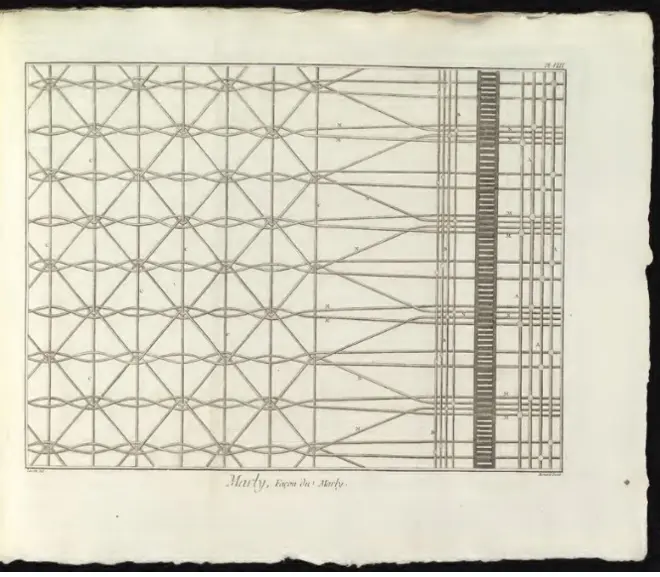
gallica.bnf.fr / Bibliothèque nationale de France
Let’s consider the ways in which we can challenge the perceived constraints of external accrediting agencies to yield future-forward educational thinking that can possibly impact the future of practice. Let’s imagine where and how professional degree programs might deliberately question the lines — to skirt the boundaries. How might the bridge be strengthened between the academic studio and the professional one, and how might we establish relevant and reciprocal models of curricula that exploit the shared space between the academy and practice? Education and practice are intertwined: Education can inform practice and, likewise, practice can inform education.
What Now?
We can all agree that architectural practice requires the integration of different kinds of knowledge and expertise to succeed. As design teams address increasingly multifaceted and complex problems, the roles of architects — as facilitators, choreographers, directors, leaders — have never been more important. The academy sets the table, so to speak, to prepare students to be the transformative leaders of profession. As Herbert Simon aptly describes,
“The real subjects of the new intellectual free trade among the many cultures are our own thought processes, our processes of judging, deciding, choosing and creating. We are importing and exporting from one intellectual discipline to another ideas about how ... a human being ... solves problems and achieves goals in outer environments of great complexity”3).
It is these actions, precisely, of importing and exporting ideas that summarizes the actions we exercise daily in our academic and professional pursuits — in this discipline of architecture. Hence, in the fictions we set in our interdisciplinary design studios, we deliberately position diverse viewpoints in relationships devised to prompt energetic and productive development toward design solutions, with the expectation that we build each student’s capacities in critical design thinking and encourage strategic, smart thinking across disciplines. Counter to the position offered by Nicolescu earlier in this essay, we envision that productive intersections between different domains of knowledge hold the potential to be full, not empty, ensembles. We expect misalignments and miscues. This is how we learn: by failing forward.
Lessons from practice carry the potential to inform lessons in education. Advancing innovative curricular models, in turn, impacts models of practice. Ultimately, practicing effective collaboration is essential to the success of the next generation of architects, redefining and redesribing our roles as interdisciplinary thinkers and agents.
In this future-forward world, one plus one will, indeed, equal more than two.
References:
Diderot, Denis and le Rond d’ Alembert, Jean. Encyclopédie, ou dictionnaire raisonné des sciences, des arts et des métiers. Planches t. 10. Paris: Briasson, 1751–1765.
Nicolescu, Basarab. Manifesto of Transdisciplinarity. Albany: State University of New York Press, 2002.
Simon, Herbert A. The Sciences of the Artificial, third edition. Cambridge: MIT Press, 1998.
Footnotes:
1 Portions of this essay have been previously published in Interdisciplinary Design Thinking in Architecture Education, Julie Ju-Youn Kim, editor (London: Routledge, 2023).
2 I produced an edited report, “Dialogues in Design Thinking: Reconsidering the Interdisciplinary Studio Experiment in the School of Architecture at Georgia Tech” (Georgia Tech School of Architecture, 2020). This publication offers a retrospective overview of the first five years of the interdisciplinary undergraduate architecture design studios.
3 Simon, 138
Julie Ju-Youn Kim, AIA, is the William H. Harrison Professor and Chair at the Georgia Institute of Technology School of Architecture, where she founded and currently directs the Flourishing Communities Collaborative, an interdisciplinary research and design lab. Incorporating goals of equity and inclusion in scholarship and design pedagogy, Julie received the 2023 AIA Georgia Educator of the Year and the 2023 ACSA Collaborative Practice Award, for connecting the academy and architectural practice by creating replicable models of engagement to expand equity through access. As both an educator and a practitioner, Julie’s research advances the discourse around the future of the discipline and practice of architecture. With support from the New Venture Fund/Public Interest Technology-University Network and Partnership for Inclusive Innovation, Julie’s teaching and research leverages data-driven and quantitative methodologies to solving social and cultural problems in the built environment. Julie is a licensed architect whose publications link her leadership and teaching in pursuit of interdisciplinarity in architecture education, research and practice. As editor and author of four chapters of “Interdisciplinary Design Thinking in Architecture Education” (London: Routledge, 2023), Julie extends the dialogue to a global scale, bringing practice and pedagogy into a single conversation.
Professor Kim has been featured in international journals including SPACE, Korean Architect and Architectural Record, and her professional work has received recognition from awards programs including an AIA/DC Unbuilt Award, SARA Design Award and an AIA National Honor Award. She is the editor of “Dialogues in Design Thinking: Reconsidering the Interdisciplinary Design Studio Experiment in the School of Architecture at Georgia Tech” (Georgia Tech, 2021); co-editor for “Radical Good Trouble: A Studio Report” (Georgia Tech, 2021); and invited author for a chapter and co-author of the conclusion in “Teaching and Designing in Detroit: Ten Women on Pedagogy and Practice” (Routledge, 2019).
Professor Kim’s previous academic appointments include associate chair and director of the Undergraduate Program at Georgia Tech School
of Architecture; associate professor, director of the Summer Institute and director of the Comprehensive Building Design Studio at the
Catholic University of America; associate professor and director of the Graduate Program at the University of Detroit Mercy; lecturer at the
University of Maryland; visiting professor for the Paris International Studio at Lawrence Technological University; and visiting professor
at Boston Architectural College. She earned her Bachelor of Arts from Wellesley College and her Master of Architecture from the
Massachusetts Institute of Technology. She can be reached at julie.kim@design.gatech.edu.

